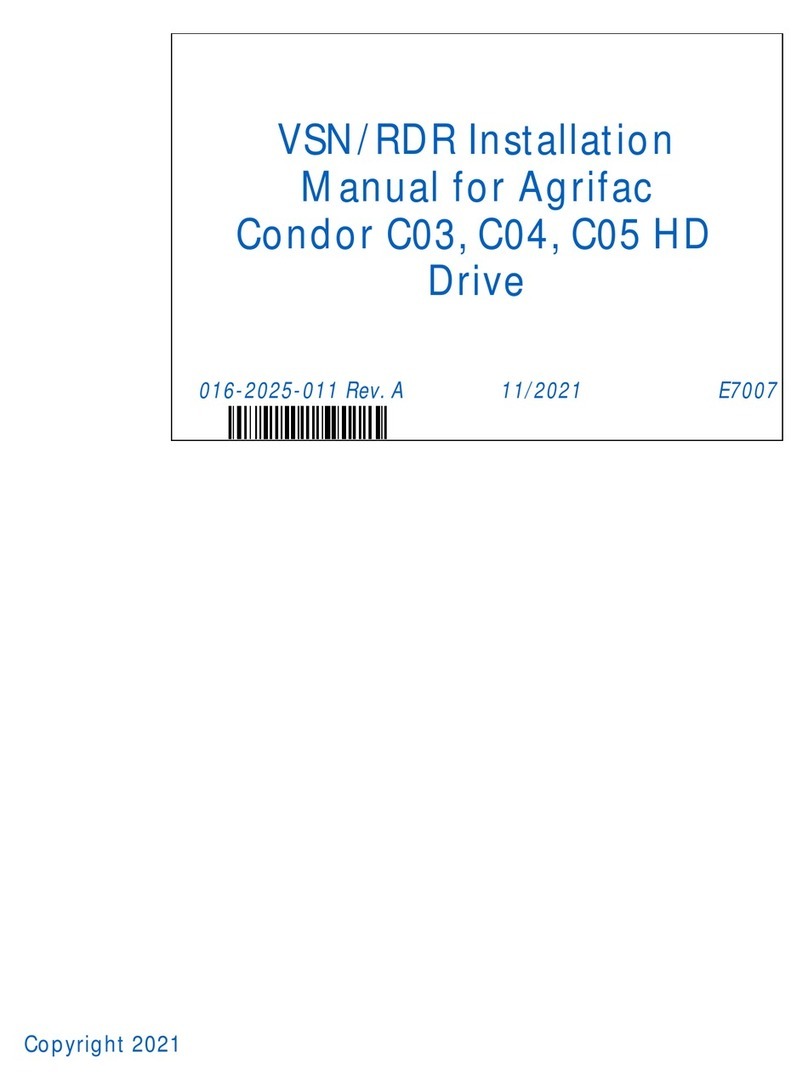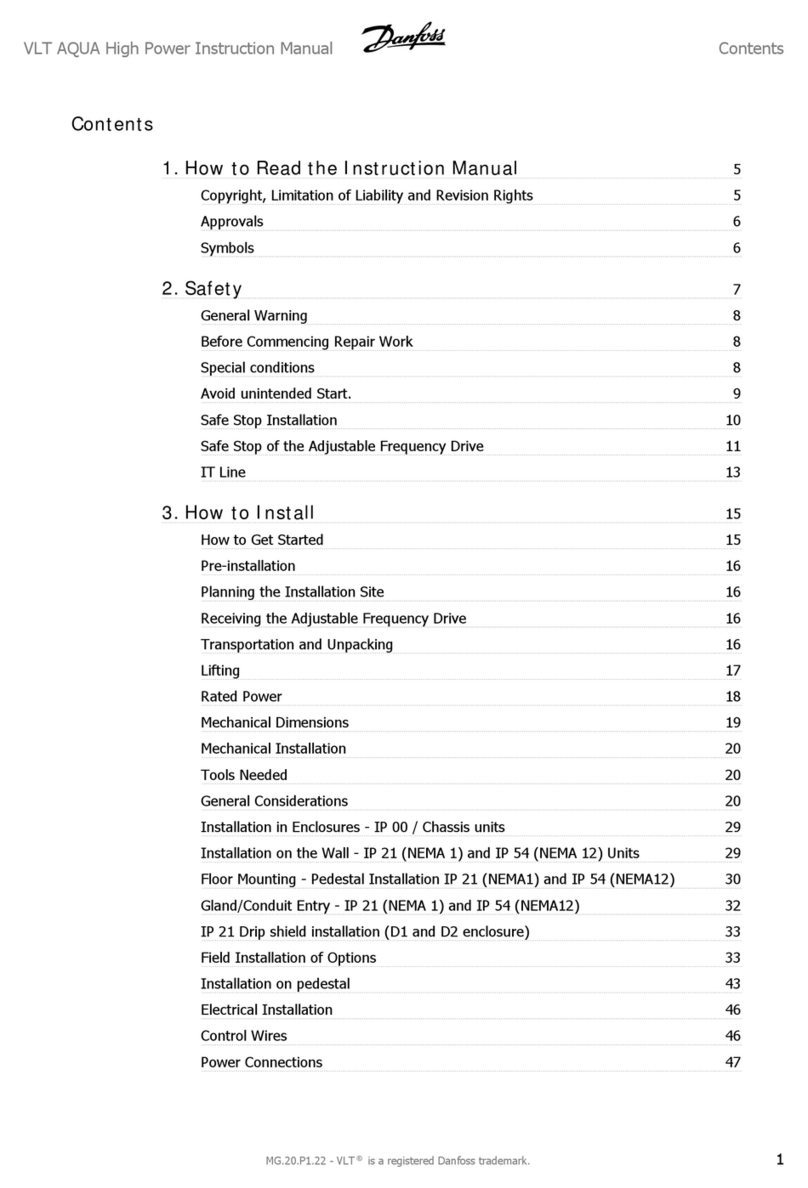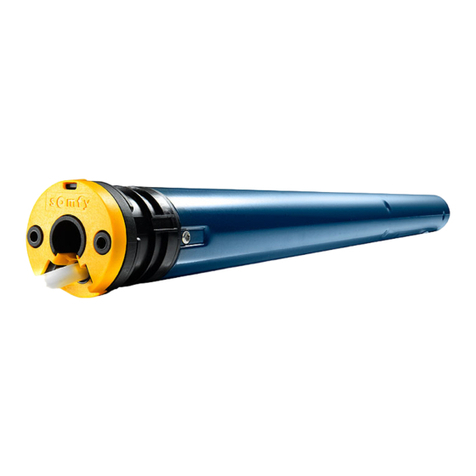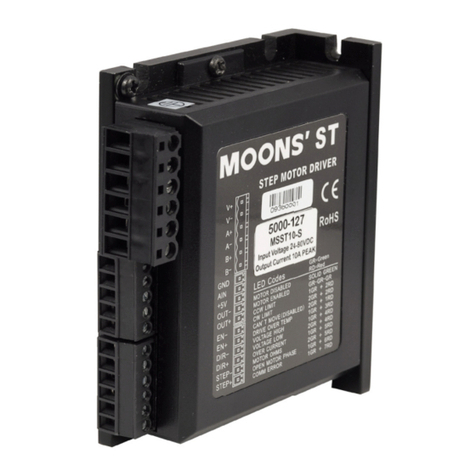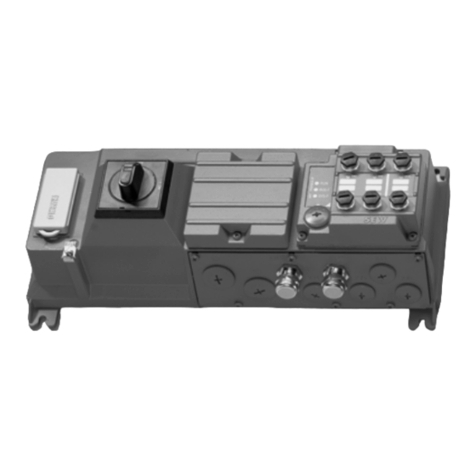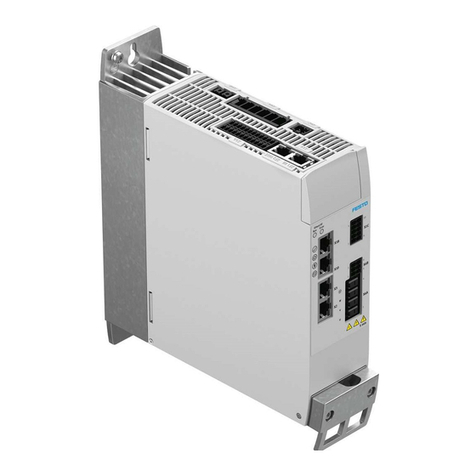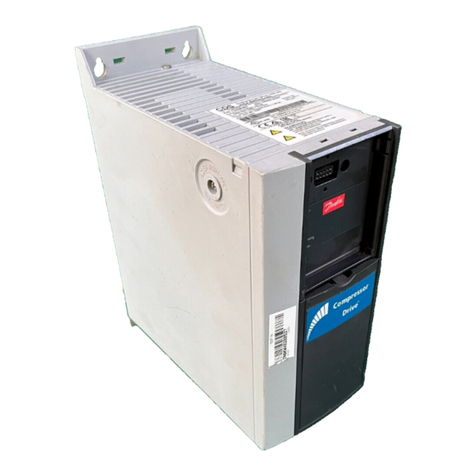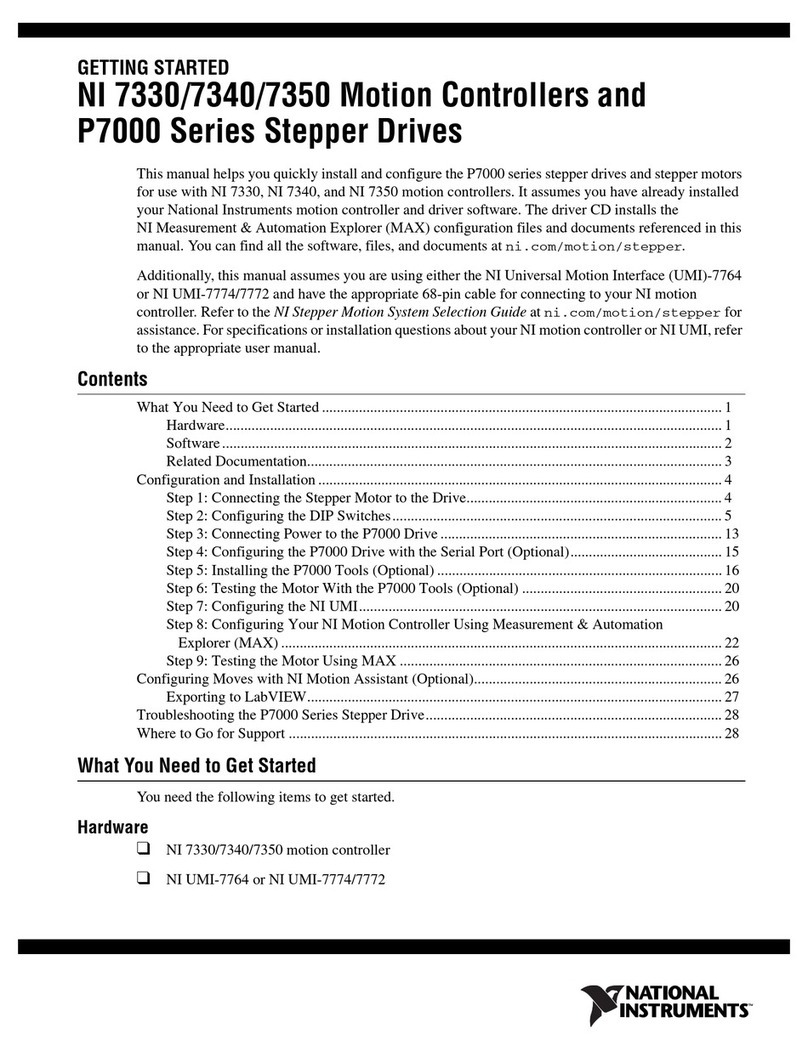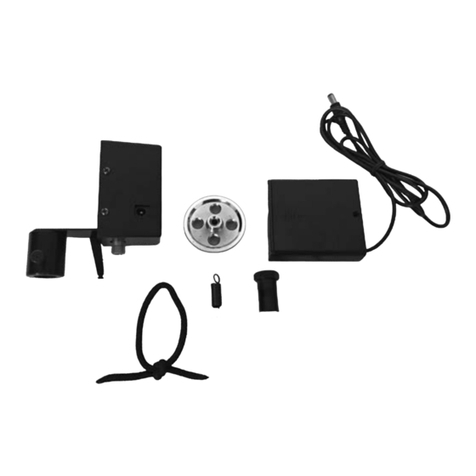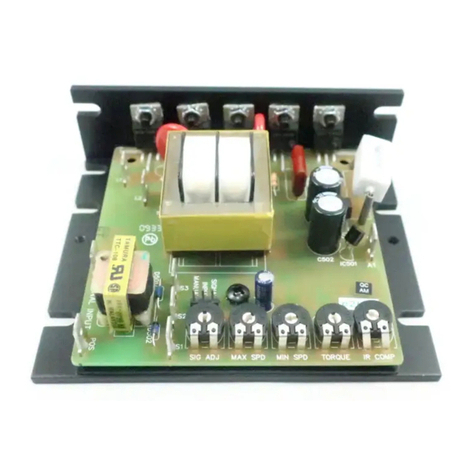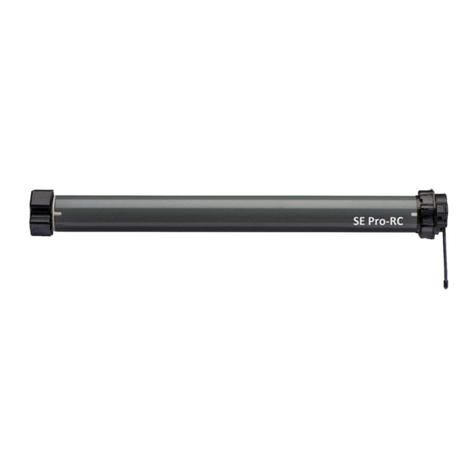Dietz DSV 5444 / ML 2 Training manual

VECTORDRIVE DSV 5444 Top technology in drive electronics
07.07.04 10:12 Dietz-electronic page 1 of 60
Frequency inverter
MULTIDRIVE
DSV 5444 / ML 2
For dynamic speed and position setpoint control
of three-phase AC motors
Commissioning Instructions
Issue 04/00
Right to Technical Modification Reserved
All previous issues of this manual are herewith invalid.

VECTORDRIVE DSV 5445 Top technology in drive electronics
07.07.04 10:12 Dietz-electronic page 2 of 60
Dear customer / user,
System DSV 5444 offers you a high-quality, modern and very powerful drive concept.
The customer/user should read these instructions carefully and should have understood them be-
fore starting work.
The following products:
DSV 5442 ; DSV 5432 ; DSV 544 CNC ; DSV 5444 ; DSV 5445 ; DSV 5452 ; DSV 5453 ;
UZV 0012 ; UZV 0013 ; UZV 0014 ; UZV 0015 ; UZV 0016 ; DSV 5445/5453-Plus-Serie ;
GNV 2710 ; GNV 252 ; GNE 211 ; GNE 2410 ; GSV 544x , 122 DZE ; 122 DZS ,
KD 915 , KD 920 ; Fine HF-SET 93251340268 (DSV 5452 incl. movable cubicle) ;
Brake resistors 4...40 Ohm (Type Cressall, Frizlen, Danotherm),
comply with the following directives and standards:
Low voltages directive 73/23/EWG - Amendment 93/68/EWG
EMC directive 89/336/EWG - amendments 92/31/EWG and 93/68/EWG
including the appropriate amendment directives up to date of drawing.
The following standards are used:
EN 60204-1 1997 IEC 61000-3-2: 1995 EN 55011: 1991
EN 61800-3 pr A.1.1 1999 IEC 61000-3-2/A1: 1997 EN 55011/A1: 1997
EN 61800-3 pr A11 ; 1999 IEC 61000-3-2/A2: 1998 EN 55011/A2: 1996
EN 61800-1 1999 EN 61800-2 1999 prEN 61800-4 2000
EN 12015 1998 EN 12016 1998 VDE 0660 Part 500 (IEC 439, EN 60439)
The declaration covers the modules and units delivered by us, but the user must ensure that the
machine complies with the directives applicable to the end product after mounting or installation.
Dietz-electronic GmbH
Max-Planck-Straße 15
72639 Neuffen
Telephone: 07025/101-0
Telefax: 07025/5824
Email: info@Dietz-electronic.de
http://www.Dietz-electronic.de

VECTORDRIVE DSV 5444 Top technology in drive electronics
07.07.04 10:12 Dietz-electronic page 3 of 60
Contents
1 Overview of commissioning 5
2 General notes 6
2.1 Selecting the assembly site 6
2.2 Lines, cross-sections, fuses, relays 6
2.3 Applicable standards and safety provisions 6
3 Power circuit 7
3.1 Power connection with external mains filter 7
3.2 Multiple axis application with UZV 0016 8
3.3 Mains connection 8
3.3.1 Mains fuses and power chokes 9
3.3.2 Operation with leakage current safety device 9
3.4 Motor connection 9
3.4.1 Power chokes 10
3.4.2 Thermistor 10
3.5 Earthing 10
3.6 Screening of lines 11
3.7 Radio interference suppression 11
3.7.1 Mains filter 11
3.7.2 Installation instructions for radio interference suppression 11
3.8 Braking module (optional) 12
3.9 Intermediate circuit coupling (optional) and Intermediate circuit protection 12
3.10 Voltage Supply of the Fans at Dimension 4 and 5 13
4 Control unit / Inputs and Outputs 14
4.1 Digital inputs and outputs 14
4.2 Freely programmable inputs and outputs on connector X2 (optional) 14
4.3 Fixed programmable inputs and outputs on connector X1 14
4.4 Interface (connector X4) 15
4.5 Transducer input (connector X3) and transducer cable 16
5 Operation 17
5.1 Frequency inverter (FI) control 17
5.1.1 Operation of FI control 17
5.1.2 Menus 18
5.1.3 Status designation 18
5.1.4 LEDs 18
5.1.5 Procedure for changing variables and parameters 19
5.2 TER.EXE terminal program 20
5.2.1 Operation 20
5.2.2 Procedure for changing parameters 21
5.2.3 Graphic actual value display „F9“ 21
5.2.4 On-line mode «F3» 21
6 Setting parameters 22
6.1 Speed control parameters 22
6.2 Position control parameters 22
6.3 Standardization 23
6.4 Number of rotary position transducer points 24
7 List of parameters 25
8 Errors 30
8.1 Error messages on integral operator unit (FI CONTROL) 30
8.2 Other faults: 30

VECTORDRIVE DSV 5445 Top technology in drive electronics
07.07.04 10:12 Dietz-electronic page 4 of 60
9 Programming 32
9.1 Command interpreter 32
9.1.1 Blocks 33
9.1.2 Conditions 33
9.2 List of all commands 33
9.2.1 General commands 33
9.2.2 Speed control 34
9.2.3 Position control 34
9.2.4 Synchronous operation 34
9.2.5 Change-over 34
9.2.6 Memory commands 35
9.2.7 Computer commands 35
9.2.8 Output commands 35
9.2.9 Other commands 35
9.3 List of main memory locations 36
9.3.1 General 36
9.3.2 Speed control 37
9.3.3 Position control 39
9.3.4 Temporary synchronization 39
9.3.5 Speed control 40
9.3.6 mathematic operations 40
9.3.7 Counter and Timer 40
9.3.8 Inputs and outputs 40
9.3.9 Variables for test purposes 41
9.3.10 Example of command program "DEMO.KOM" 42
9.4 Inverter communication modes 44
9.4.1 "B3 mode" dialogue operation 44
9.4.2 "B2 mode" short message operation 45
9.4.2.1 Communication time-frame 45
9.4.2.2 Short message commands 45
9.4.2.3 Short message mode commands and messages 45
9.4.2.4 Three-digit short-message system messages 49
9.4.3 Optimized short message traffic for RS485 49
9.4.3.1 Acknowledged "B5 mode " 49
9.4.3.2 Unacknowledged "B5 mode " 49
9.5 Addressed bus mode 50
10 Appendix 50
10.1 Options 50
10.1.1 Transducer output connector X6 51
10.1.2 Option card: Differential 2-channel analog output 51
10.1.3 Option card: 2 voltage-less contacts 52
10.1.4 Option card: "SSI absolute value transducer input" 52
10.1.5 Option card: 2nd transducer 53
10.2 Bus connection options 54
10.3 Installing firmware on control card and in FI Control 54
10.4 Conversion table for cosϕ, sinϕand tanϕ55
10.5 Other information 55
10.6 Dimension and weight 56
10.7 Dimension and weight with add-on filter 57
10.8 Dimension and weight with 2 options 58
10.9 Dimension and weight with 2 options and add-on filter 58
10.10 Dimension and weight size 5 59
10.11 Connection layouts 60

VECTORDRIVE DSV 5444 Top technology in drive electronics
07.07.04 10:12 Dietz-electronic page 5 of 60
1 Overview of commissioning
Cut down the commissioning time for your VECTORDRIVE DSV 5444 by only carrying out the steps needed
for your own application. The relevant section titles in these instructions can be found in the individual boxes.
Connection power circuit
♦Power circuit
♦Motor connection
♦Brake module (optional)
♦Intermediate circuit coupling (optional)
Customized construction with control
program
Standard construction
Connection control unit Connect control unit
♦note customer application information
on terminal assignment
♦Freely programmable inputs and out-
puts (connector X2) (optional)
♦Fixed programmable inputs and outputs
(connector X1)
♦Interface (connector X4)
♦Transducer input (connector X3) and
transducer cable
♦Freely programmable inputs and out-
puts (connector X2) (optional)
♦Fixed programmable inputs and outputs
(connector X1)
♦Interface (connector X4)
♦Transducer input (connector X3) and
transducer cable
Connect unit Connect unit
Optimise parameters Set parameters
♦Operation
♦Set parameters
♦List parameters (see note below)
♦On-line mode «F3» in terminal program
TER.EXE (auto-parameter setting)
Setting ended Optimise parameters
♦Operation
♦Set parameters
♦List parameters
Create control program
♦Programming
☞
As a rule there is customer application documentation as well, i.e. the DSV already includes a
program «Kunde.KOM» (Customer command) which can be altered by means of the
«Kunde.CNF» menu guide. There are assignment lists and explanations for this in the form of
auxiliary files such as «KUNDE.TXT», «KUNDE.DOC» or «KUNDE.INF».
In this case follow the procedures stated!

VECTORDRIVE DSV 5445 Top technology in drive electronics
07.07.04 10:12 Dietz-electronic page 6 of 60
2 General notes
2.1 Selecting the assembly site
♦The VECTORDRIVE DSV 5444 frequency inverter is designed for use indoors.
♦When selecting your assembly site, make sure that there is adequate ventilation. There must be a gap of
at least 10cm for the top and bottom cover sheets.
♦A side gap of at least 1 cm must be maintained on units of size I-III and at least 10 cm on units of size IV.
The specified installation position is vertical.
♦To ensure trouble-free operation of your installation, it is advisable to install the frequency inverter and
ancillary equipment in a switch-cubicle of appropriate design, complying with the applicable EMC regula-
tions.
♦The ambient temperature for the standard design should not fall below 0 °C or exceed 60 °C.
From 35 °C, the power output should be reduced to 1.5 %/°C for sizes I - III and 5 %/°C for size IV.
♦Do not install the unit where it will be exposed to direct sunlight.
2.2 Lines, cross-sections, fuses, relays
♦All connecting lines and connections should be short and of adequate cross-section. Refer to our pro-
posed sizes for cable sections in the corresponding section, together with the standards listed. Suitable
cut-off devices (e.g. main switch, main fuse) should be provided in the mains feeder.
♦Never lay signalling and control cables together with the mains or motor lines, or else maintain adequate
spacing. Screened lines improve immunity to interference and should therefore be used for preferences.
♦Contactor and relay coils with fuses must be used for the control system. Retrofit resistor-capacitance
elements, varistors or diodes if necessary on existing installations. For new installations we recommend
using 24 V DC relays for the control system.
See also: Section Power circuit, Screening of lines
Section Power circuit, Radio interference supression
2.3 Applicable standards and safety provisions
Comply with the relevant standards and safety provisions governing your application on installation. The
following standards apply in particular:
♦DIN VDE 0100 Provisions for the erection of heavy power installations with rated voltages up to 1000 V
♦DIN VDE 0113 Provisions for the electrical equipment of processing and machining equipment
♦DIN VDE 0160 Equipment of heavy power installations with electronic operating resources

VECTORDRIVE DSV 5444 Top technology in drive electronics
07.07.04 10:12 Dietz-electronic page 7 of 60
3 Power circuit
The power circuit of the VECTORDRIVE DSV 5444 contains a six-pulse bridge connection with DC voltage
intermediate voltage and IGBT end stage. The output voltage is pulse-width modulated. The inverter outputs
are earthing-, short-circuit- and idling-proof.
3.1 Power connection with external mains filter
K1
A1
Y1
R1
NF1
PE
400V~
50/60 Hz
N
PE L2 L3L1
L1
Power terminals
F1 F2 F3
Fan connection
F4
A2
L1 NPE
U2U1 U3PE
UVWPE
30 31
L2
3~
M
L2' L3'L1'
L2 L3L1
0030_03e.drw
L1: Power choke
L2: Motor choke (only for motor cable lengths > 15 m)
A1: Power terminals (underside of unit)
A2: Fan connection (top side of unit, size 4 only)
E1: External braking resistance
Y1: Equipotential bonding rails
NF1: External mains filter

VECTORDRIVE DSV 5445 Top technology in drive electronics
07.07.04 10:12 Dietz-electronic page 8 of 60
3.2 Multiple axis application with UZV 0016
K1
3~
M
UVWPE
U2U1 U3
PE
L2
24
+
PE
400V~
50/60 Hz
N
Y1
25
3~
M
UVWPE
U2U1 U3
PE
L3
_
Y2 Y3
A2 A4
_
UZV 0016
DSV DSV
NF1
24 25
+_
F8 F9
DC-bus:
intermediate
circuit protection
of UZV 0016
screened DC-bus line
Fan connection
F4
L1 N PE
A3
F6 F7
0055_01e.drw
F1 F2 F3
L2' L3'L1'
L2 L3L1
PEL2 L3L1
L1
A1
30 31
R1
24 25
+
F5
L1 N PE
A5
Fan connection
L1: Power choke
L2, L3: Motor choke (only for motor cable lengths > 15 m)
A1: Connection terminals of UZV 0016
A2, A4: Connection terminals of frequency converters
A3, A5: Fan connection (top side of unit, size 4 only)
R1: External mains filter
Y1, Y2, Y3: Equipotential bonding rails
NF1: External mains filter
F1...F3: Mains fuses
F6...F9: External intermediate circuit protection
3.3 Mains connection
The VECTORDRIVE DSV 5444 is designed for fixed connection to the 400 V AC 50/60 Hz AC network
(optionally 480 V AC 50/60 Hz). Lines for the mains supply L1, L2 and L3 and the safety earth PE are located
on the underside of the unit.
From size IV on, (VECTORDRIVE DSV 5444-60...130), the internal fan must have a separate supply. The
power consumption is about 70 W.
The corresponding connection terminals 1 AC 230 V (terminals L1 and N) are on the cover plate.
See also: Section Power circuit, Earthing
Section Power circuit, Mains fuses and power chokes
Section Power circuit, Mains filter

VECTORDRIVE DSV 5444 Top technology in drive electronics
07.07.04 10:12 Dietz-electronic page 9 of 60
3.3.1 Mains fuses and power chokes
The unit feeder must be fused and fitted with power chokes to attenuate phase effects. The core of the power
choke should be earthed.
The design of fuses and chokes should be determined on the basis of the table below. The minimum cross-
section of the mains feeder is dictated by the mains fuse and type of installation.
VECTORDRIVE DSV
5444-
Mains fuse
3x (time-lag)
Power choke
3x 4% uk[mH]
3..6 (S/L) 6 A 2,40 - 10 A
9 (S/L) 16 A 2,40 - 10 A
12 (S/L) 16 A 0,70 - 35 A
16 (S/L) 25 A 0.70 - 35 A
25 (S/L) 35 A 0,70 - 35 A
32 (S/L) 50 A 0,70 - 35 A
45 (S/L) 63 A 0,50 - 50 A
60 (S/L) 80 A 0,50 - 50 A
80 (S) 100 A 0,30 - 80 A
80 (L) 125 A 0,30 - 80 A
100 (S/L) 125 A 0,25 -100 A
130 (S/L) 160 A 0,20 -120 A
S = Standard L = Lift version
3.3.2 Operation with leakage current safety device
It is only possible to use leakage current safety devices (F1) in conjunction with frequency inverters in certain
circumstances. Check national standards to see whether a leakage current safety device is admissible for
your application. In the event of a fault, DC currents can occur on the mains side with frequency inverters.
You should therefore only use leakage current safety devices suitable for DC leakage currents.
Mains filters under some operating conditions (e.g. failure of one phase) can cause high discharge current,
resulting in spurious tripping of the safety device. Switching devices on the mains side, such as mains switch
or fuse, must therefore switch symmetrically. Rotary switches are generally unsuitable for use with mains
filters.
3.4 Motor connection
The motor phases U, V, W are connected to the terminals U1, U2, U3 on the underside of the frequency
inverter. The motor housing should be earthed, e.g. to the additional PE terminal. Make sure that the phase
sequence is maintained for clockwise phase sequence, otherwise the motor will turn to the left for positive
setpoint values. The line cross-sections of the motor feeder are dictated by the rated current of your fre-
quency inverter. Only use screened motor feeders if no output filter or add-on filter is used.
Operating with low speeds and high motor currents causes serious overheating of the motor. It may be that
self-cooling or self-ventilation are no longer sufficient. In this case the motor must be fitted with an external
fan and temperature sensor (thermistor).
With parallel operation of several motors with one inverter, the cumulative motor current must not exceed the
rated equipment current.
If the motor is operated above its rated frequency (standard 50 Hz motor), check the limit speed. Ask your
motor manufacturer if in doubt.

VECTORDRIVE DSV 5445 Top technology in drive electronics
07.07.04 10:12 Dietz-electronic page 10 of 60
3.4.1 Power chokes
Irrespective of EMC regulations, power chokes must be used for motor cable lengths of more than 15 m to
limit the capacitive discharge current. The chokes also reduce the voltage rise velocity du/dt on the motor
winding. We recommend an inductance value per phase as follows for choke inductance:
LRated motor current A H=µ
8000
[]
[]
The power chokes are to be designed for the inverter PWM frequency of 5 kHz. If our add-on filter option is
used, power chokes will be required for cable lengths of 45 m and over.
With high-frequency motors, power chokes must in principle be incorporated irrespective of cable length, as,
compared to standard motors, the harmonic content of the current and hence motor temperature rise are
increased.
High frequency motors in this respect are motors with the following rated motor voltage to rated motor fre-
quency value:
Rated motor voltage
Rated motor frequency ≤15.Vs
Example: Rated motor voltage Un= 380V
Motor frequency fn= 300Hz
U
f
n
n
==
380 V
300 Hz 127.
as 1.27 < 1.5, power chokes must be used.
3.4.2 Thermistor
The motor temperature monitoring system protects the connected motor against thermal overload. In the
event of excessive temperature rise in the winding, the inverter automatically cuts out. Connect the motor
thermistor with a screened line to terminals 23 and 24 on the front panel. For motors without a thermistor,
terminals 23 and 24 are to be bridged.
3.5 Earthing
Earthing consists of a safety earth and a functional earth. If earthing is inadequate or missing, this can cause
malfunctions, or even damage the inverter. Particular care should therefore be taken with installation, noting
the following points:
♦Select the optimum earthing solution for integration (e.g. switch-cubicle mounting plate).
♦Ensure that all metallically conductive housing components are connected with suitable lines of adequate
cross-section.
♦Ensure maximum contact surfaces of the components (skin effect). Remove any paint to ensure a sound,
flat contact surface.
♦Identify a central earthing point, e.g. on a potential compensating rail. Start the earth from this in a star
layout to the corresponding connections.
♦Avoid earthing loops.
♦Iron choke cores must be earthed.
♦The motor housing must be included in the equipotential bonding.

VECTORDRIVE DSV 5444 Top technology in drive electronics
07.07.04 10:12 Dietz-electronic page 11 of 60
3.6 Screening of lines
♦Cables between the inverter output and the motor must be screened (if an output filter is not used). For
long cables, the screen must in addition be earthed every 25 m.
♦For digital transmission systems, connect the screen on both sides with the equipotential bonding.
♦For high impedance analog control lines the screen should be in contact on one side on the source side,
as control signal effects due to the 50 Hz ripple current cannot be ruled out.
♦All screen connections should have a large contact surface if possible with 360° contact to PE.
3.7 Radio interference suppression
Our inverters are set for radio interference suppression by means of a metal screen on the equipment itself.
The unit complies with EN55011 Radio interference of electrical operating resources and installations, limit
value class B, and ENV50141 Radio interference suppression - Test intensity III taking into account the fol-
lowing sections:
♦Power circuit, Mains filter
♦Power circuit, Installation instructions for radio interference
3.7.1 Mains filter
A mains filter or our add-on filter (optional) must be provided in the mains feeder between the power choke
and unit input.
Make sure that, depending on type, the filter can produce discharge currents up to some 100 mA in the event
of failure of one or two phases or major load unbalance in the AC current system. Filters must therefore be
earthed before switching on !!!
The mains filters we recommend are given in the table below.
VECTORDRIVE DSV 5444-.../400 Arcotronics
3 3 x 400 V 50/60 Hz 5 A F.LL.D3.005A.AN.R1
6 3 x 400 V 50/60 Hz 8 A F.LL.D3.008A.AN.R1
9 3 x 400 V 50/60 Hz 8 A F.LL.D3.008A.AN.R1
12...25 3 x 400 V 50/60 Hz 16 A F.LL.D3.016A.AN.R1
32 3 x 400 V 50/60 Hz 25 A F.LL.D3.025A.AN.R1
45 3 x 400 V 50/60 Hz 36 A F.LL.D3.036A.AN.R1
60 3 x 400 V 50/60 Hz 50 A F.LL.D3.050A.AN.R1
80...100 3 x 400 V 50/60 Hz 80 A F.LL.D3.080A.AN.R1
130 3 x 400 V 50/60 Hz 110 A F.LL.D3.110A.AN.R1
3.7.2 Installation instructions for radio interference suppression
♦The unit, power chokes, filter and accessories must be incorporated in a metal switch-cubicle.
♦The line lengths between external mains filter and unit input must not exceed 0.5 m. The line must be
screened.
♦Screened motor lines must be connected on both sides to the equipotential bonding. The total length of
screening breaks (e.g. for power chokes, motor fuses) must not exceed 10 cm per phase.
♦Control lines and mains feeders should be laid separately from the motor cables.
♦Connecting cables for braking resistors and intermediate circuit connections, where applicable, must be
screened.

VECTORDRIVE DSV 5445 Top technology in drive electronics
07.07.04 10:12 Dietz-electronic page 12 of 60
Products bearing the CE symbol meet the requirements of EU Guidelines 89/336EEC «Electromagnetic
compatibility» and the standardized European standards contained therein. If installation complies with the
stated instructions, the requirements of EU guidelines Machines 89/392/EEC are fulfilled.
The EU compliance certification will be made available in line with the above EU guidelines, Article 10, at:
Dietz-electronic GmbH & Co
Max-Planck-Str. 15
D-72639 Neuffen
3.8 Braking module (optional)
The units can be retro-fitted as a special design with a braking option to dissipate braking energy in fast
braking operations or with large centrifugal masses. In addition, an external braking resistor with screen line
as per the table must then be connected to terminals 30 and 31. The power loss of the braking resistor must,
depending on braking frequency, be between 0.2 kW and 11.0 kW. In the case of assembly by customer,
proper heat dispersal and safe contact protection must be ensured. We also recommend fitting the external
baking resistor with a temperature monitoring facility, which cuts out the frequency inverter mains fuse if the
braking resistor gets too hot.
The braking resistors we recommend are listed in the table below:
VECTORDRIVE
DSV 5444-
Braking
resistor [
Ω
ΩΩ
Ω
]
Power loss S1
Standard [kW]
Cross-section
Standard [mm²]
Power loss S1
Lifting system
[kW]
Cross-section of
lifting system
[mm²]
3..9 63,0 0,25 1,5 0,25 1,5mm2
12..16 41,0 0,33 1,5mm20,33 1,5mm2
25 20,0 0,45 1,5mm21,00 1,5mm2
32..45 18,8 1,00 1,5mm22,00 2,5mm2
60..80 14,4 2,00 2,5mm24,00 2,5mm2
100 13,0 4,00 2,5mm² 6,50 2,5mm2
130 13,0 6,50 2,5mm26,50 4,0mm2
3.9 Intermediate circuit coupling (optional) and Intermediate circuit protection
On units of DC-bus 570 V design and external supply, several drives can be connected to one power supply
unit. In this case connect terminals 24 (+UB) and terminals 25 (-UB) together on the underside of the unit.
Each intermediate circuit (+UB and -UB) must be protected against short-circuit separately. The DC connec-
tion installation between the individual units should be as short as possible and constructed with screened
lines. Connections with polarity reversal on the intermediate circuit connections cause immediate damage to
the units. Make sure that you check for the correct polarity before switching on !
Intermediate circuit protection
To ensure safe operation of the VECTORDRIVE DSV 5444-3...130/570, we recommend using semi-
conductor fuses as listed in the table below:
VECTORDRIVE DSV 5444-.../570 ZK-fuses
2x gR 660/690V [A]
Minimum cross-section [mm²]
3..9 25 4
12..16 35 6
25..32 50 10
45 63 16
60 80 25
80 125 35
100 160 50
130 200 50

VECTORDRIVE DSV 5444 Top technology in drive electronics
07.07.04 10:12 Dietz-electronic page 13 of 60
3.10 Voltage Supply of the Fans at Dimension 4 and 5
On request becomes the devices of the DSV 54** -series in the size 4 and 5 too for an fan voltage of 400
VAC equip delivered as up to now 230 VAC. A small autotransformer is integrated into the device. Dimension
5 is a new dimension which covers the range from 75 kW up to 100 kW.
Considering is the pin assignments at the 4-pole supply connector:
1) Standard (without autotransformer):
The most uppermost Pin of the connector must not become engaged here!
2) Version "Focus dynamics" (with autotransformer, devices as from 01.05.99):
Important: Only if the supplied connector has the denotation "L2" at the most uppermost pin, the selectable
pin allocation is possible with 400 VAC or 230 VAC!
Considering is with the 400 VAC connection, that two external fuses between 2AT and 4AT are to be planned
for the two phases L1 and L2.
Free pins may never be engaged i.e. never engage L1, L2 and N!

VECTORDRIVE DSV 5445 Top technology in drive electronics
07.07.04 10:12 Dietz-electronic page 14 of 60
4 Control unit / Inputs and Outputs
4.1 Digital inputs and outputs
The inverter has freely programmable inputs and outputs as well as several fixed wired inputs and outputs.
This enables simple control tasks to be handled. A voltage of 30 V DC must not be exceeded under any cir-
cumstances on inputs and outputs. The control voltage must be smoothed with electrolytic capacitors.
Each output can handle a maximum current of 0.1A with a maximum voltage of 24 V DC. The power supply
to the outputs is via pin 11 and pin 12 on connector X1 from an external power source. The power supply
should have a 2AT fuse. Inputs operate with a voltage of 15 - 24 V DC. They require a current of 10 mA each.
The voltage relates to the frame earth terminal on pin 11 of connector X1.
4.2 Freely programmable inputs and outputs on connector X2 (optional)
The freely programmable inputs and outputs are accessible on connector X2.
Treminal Abbreviation Assignment Terminal Abbreviation Assignment
1 A7 Output 7 9 E7 Input 7
2 A6 Output 6 10 E6 Input 6
3 A5 Output 5 11 E5 Input 5
4 A4 Output 4 12 E4 Input 4
5 A3 Output 3 13 E3 Input 3
6 A2 Output 2 14 E2 Input 2
7 A1 Output 1 15 E1 Input 1
8 A0 Output 0 16 E0 Input 0
Each input can also be interrogated statically by means of flags. The addresses are given in the section Pro-
gramming, Inputs and Outputs.
4.3 Fixed programmable inputs and outputs on connector X1
The fixed wired inputs on connector X1 are dominant. This means that the commands of a control program
are overridden, and a control program must be set accordingly. The supply conductors for the ISP, INT and
E8 signals and for the setpoint values must be screened to prevent any feedthrough.
The following functions are provided:
Terminal Name Function
2 A9 (SI) This output A9 is freely programmable
3 BB Ready for operation. The output is set when the inverter and supply unit are ready for
operation. The signal is also displayed by the left LED on the front panel.
5 ISP Pulse barrier, blocks the end stage of the inverter.
6 E8 Freely programmable input. If this input is not used, it must be set at 24 V (high) (see
section Programming, Blocks)
8 INT This input is used for an external transducer zero pulse.
11 0 V Earth for external 24 V supply voltage
12 24 V Connection for external 24 V supply voltage
19 1SW+ 1st setpoint value "+"
17 1SW- 1st setpoint value "-"
18 SGND Setpoint earth
25 2SW- 2nd setpoint value "-"
15 2SW+ 2nd setpoint value "+"
20 +15 V Internal +15 V
22 -15 V Internal -15 V
23 KMR Thermistor input, input for motor temperature monitoring
24 KMH Thermistor input, input for motor temperature monitoring
☞Examples of terminal assignment for specified analog setpoint values can be found in the Ap-
pendix.

VECTORDRIVE DSV 5444 Top technology in drive electronics
07.07.04 10:12 Dietz-electronic page 15 of 60
4.4 Interface (connector X4)
The serial interface is used to set the parameters for, operate, and control the inverter. The interface can be
operated optionally in accordance with RS-232 or RS-485 standards.
♦Use the RS-232 configuration if you want to set and run the inverter with the TER.EXE terminal program
and a PC or Laptop.
♦The RS-485 configuration is used to control several inverters with a higher ranking control or a control
computer (multiple axis application).
The serial interface has a fixed setting for: 9600 Baud
8 bits
1 Stop bit
no parity
Interface assignment:
Terminal Designation
1 RS485+
2 RS232 TXD
3 RS232 RXD
4 RS485-
5GND
6 RS485 transfer: bridge to GND
7GND
8 External interface: bridge to GND (FI control deactivated)
9+5V
♦For RS232 operation, pin 8 must be connected to GND (pin 5 or 7). Pin 6 may not be bridged.
♦For RS485 operation, pin 8 and pin 6 must be connected to GND (pin 5 or 7).
RS232 cable (connection VECTORDRIVE DSV 5444
↔
↔↔
↔
computer)
2
3
TXD
RXD
GND
8
5
2
3
5
TXD
RXD
GND
DSV side Computer side
SUB-D 9p
female
SUB-D 9p
female
0006_03e.drw
8
2
3
TXD
RXD
GND
8
5
2
3
7
TXD
RXD
GND
DSV side Computer side
SUB-D 9p
female
SUB-D 25p
female
0006_03e.drw

VECTORDRIVE DSV 5445 Top technology in drive electronics
07.07.04 10:12 Dietz-electronic page 16 of 60
RS485 terminal assignment for multiple axis application
4.5 Transducer input (connector X3) and transducer cable
Rotary position transducer input assignment (15-pole male D-unit connector) and connector on rotary position
transducer (12-pole round connector IP65):
Connector X3 12-pole round connector (IP-65) Assignment
15 UA1-IN+
26 UA1-IN-
312 VCC
410 GND
58 UA2-IN+
61 UA2-IN-
73 UA0-IN+
84 UA0-IN-
9 - I-screen
10 - -15 V
11 (11 if required) GND-Sense
12 Housing (9 if required) A-screen
13 (2 if required) VCC-Sense
14 (7 if required) Alarm
15 - +15 V
♦Use our transducer cable for preference (order N° 95441812)
♦The unit has a default setting for a transducer with 1 Vss - level 4 x 90°, 1024 pulses as standard.
☞Jumper JP3 can be used to switch from the sinusoidal transducer (standard) to a rectangular
transducer (see section Appendix, Installin firmware on control card and in FI control). For this,
the address 708h should be loaded in block 16 as 255!

VECTORDRIVE DSV 5444 Top technology in drive electronics
07.07.04 10:12 Dietz-electronic page 17 of 60
4.6 Operation
The parameters for the VECTORDRIVE DSV 5444 frequency inverter can be set via the internal operator unit
(FI Control) or the PC program "TER.EXE".
☞During programming, data amendment and data storage, make sure that there is no change of
signal at I/O level (connectors X1 and X2).
4.7 Frequency inverter (FI) control
The FI control consists of a two-line display with clear text and 4 keys. The FI control is only active if there is
no connection to connector X4 (RS232/RS485 interface). In passive status only error and status messages
are displayed.
4.7.1 Operation of FI control
The four keys of the FI control have the following functions:
Key Assignment/Explanation
⇑Up arrow key Select required menu point
⇓Down arrow key Select required menu point
⇐Left arrow key Leave a menu point (without changing a value => Quit option)
⇒Right arrow key Activates selected menu point
Edit a value If the required menu point is activated, the right and left arrow keys can be used
to move the cursor to the corresponding position. The up and down arrow keys
are used to change the figure or sign.
To accept a modified value, the right key should be pressed until the FI control
displays the message «VALUE ACCEPTED». The modified values are only
stored in the FI control until the «STORE VALUES» menu point is activated.

VECTORDRIVE DSV 5445 Top technology in drive electronics
07.07.04 10:12 Dietz-electronic page 18 of 60
4.7.2 Menus
By pressing the ⇑- or ⇓- keys, all the requisite parameters are first read into the FI control from the inverter. A
selection menu is then presented with the following menu points:
Menu point Assignment / Explanations
Change variables The variables in the free working memory E00h to E60h can be changed.
Change parameters Parameters F0 to F31, I, K, T, Y0 and Y1 of the inverter can be changed.
View interface With this menu point, outputs from the inverter are displayed on the interface. Line
feed is denoted by a rectangle.
Store values This menu point transfers the values to the inverter and stores them in the EEPROM
to safeguard against mains failure. The inverter then enables a RESET. This proc-
ess takes about 10 seconds. During that time, the inverter must not be switched off
or the connection with the FI control interrupted. After storage in memory, the
inverter is reset. The selection menu then reappears.
WARNING: If the original values are still present after storing the modified values,
the data save switch (R/RW switch) must be changed over between terminals X3
and X4 into the RW position.
Change operating
mode
There are currently two different operating mode options available for the FI control.
Lift variants: the function is designed specifically for this application (this operating
mode is automatically selected with the lift).
Standard operating mode: all parameters and variables are freely accessible, but
there is no customer application commentary.
WARNING: after change-over, all values are read in again. Any values not stored
therefore resume their former status.
To select, activate, quit and edit a menu point, see previous table in section Operation of FI control and sec-
tion Procedure for changing variables and parameters.
4.7.3 Status designation
Status designation Meaning
Ready for connection Inverter is ready for operation, it can be switched on
Speed control Inverter in speed control mode
Position control Inverter in position control mode
Position synchronization Inverter running with position synchronization
Speed synchronization Inverter running with speed synchronization
Pulse barrier Pulse barrier (ISP input) not connected
Control off Control switched off due to fault
Controlled Inverter running without transducer actual value (switch = 00h)
Analog operation Inverter running in analog mode
4.7.4 LEDs
LED Colour Meaning
BB yellow Ready for operation: the output is set if the inverter and power supply unit are
ready for operation. If there is no ready for operation message, check the error
message on the integral operator unit. Some faults have to be reset using the
RESET function.
A9 green User-defined: dependent on command program.

VECTORDRIVE DSV 5444 Top technology in drive electronics
07.07.04 10:12 Dietz-electronic page 19 of 60
4.7.5 Procedure for changing variables and parameters
The flow-chart below shows the procedure for changing variables and parameters with an example. Variable
3 is taken from the selection menu «Change variables» and the target ramp from the selection menu
«Change parameters».
Message in display:
All OK
Message in display:
Change variables
Message in display:
Variable 3
Edit
Message in display:
Change parameters
Message in display:
Target ramp
Edit
Message in display:
Store values ?
Message in display:
Please wait - do not switch off
(after about 10 seconds)
Please wait - Software reset
(after about 5 seconds)
All OK
Up arrow key
Down arrow key
Right arrow key
Left arrow key
Message appears in displayt: Start reading in
(after about 1 second)
Reading data
Edit: see section Operation of FI Control
0015_02e.af3
Yes No
Yes
Yes
Yes
Yes
No
No
No
No

VECTORDRIVE DSV 5445 Top technology in drive electronics
07.07.04 10:12 Dietz-electronic page 20 of 60
4.8 TER.EXE terminal program
The terminal program TER.EXE is designed for changing parameters and variables. Parameter and variable
selection can be designed for specific customer applications. Operation is menu-controlled.
Configuration file: File containing addresses and names of variables and parameters which can be
adapted individually.The file name has a «CNF» ending.
Command file: File containing the control program with associated parameters and variables.
4.8.1 Operation
Insert the floppy disk with the terminal program in the disk drive of your PC/Laptop. Copy all the files on the
floppy disk into a sub-directory (e.g. terminal) of your choice on the hard disk. Change to the sub-directory.
☞Before starting the terminal program, connect the interface between the PC and the DSV (take
care with interface cable assignment). After fitting the connection, operation via the FI control is
no longer possible.
There are two ways of calling in the program.
1. TER
The program asks for the required field name.
Start, e.g. with: TER <CR>
2. TER configuration file
The program read out of the inverter for the parameters and variables defined in the Customer.CNF.
Start e.g. with TER Customer.CNF <CR>
3. For desk parameter setting, the terminal program can be started with the following input: TER Cus-
tomer.CNF Customer.KOM <CR >
For the customer input the name of the configuration file or the name of the command program for which
the parameters are to be set.
☞Do not change, read or transmit data when the installation is running!
Once the TER.EXE terminal program is started, the following menu appears:
Function keys Selection menu Explanation
F1 Function for changing user data All parameters stated in the List of parameters
section can be read in and changed.
F2 Function for changing configuration file
F3 Standard terminal program Use for on-line programming
F4 Change-over of serial interface COM1 or COM2
F5 Transfers data from a file to the inverter
F6 Stores data from the inverter in a file
F9 Graphic actual value display Simultaneous presentation of two actual values
(e.g. speed and current)
Table of contents
Popular DC Drive manuals by other brands

Lenze
Lenze L-force EYP Series Mounting instructions
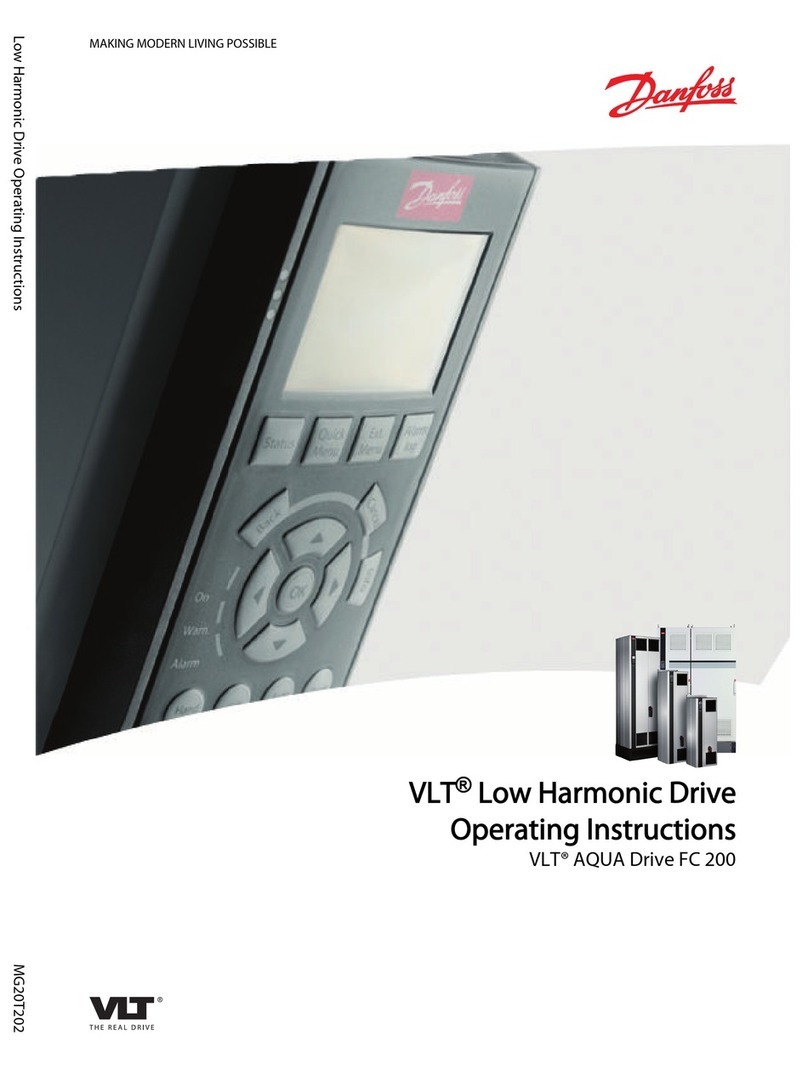
Danfoss
Danfoss VLT AQUA Drive FC 200 operating instructions
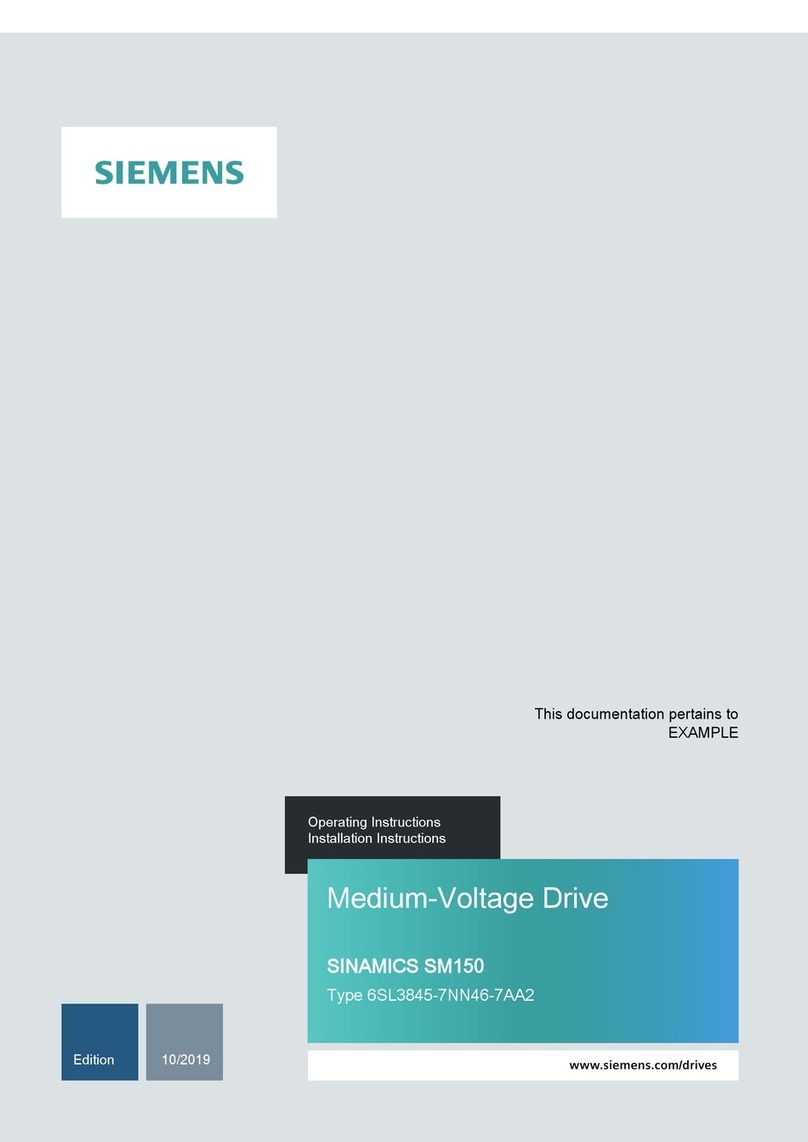
Siemens
Siemens 6SL3845-7NN46-7AA2 Operating instructions & installation instructions

Siemens
Siemens SINAMICS Equipment manual
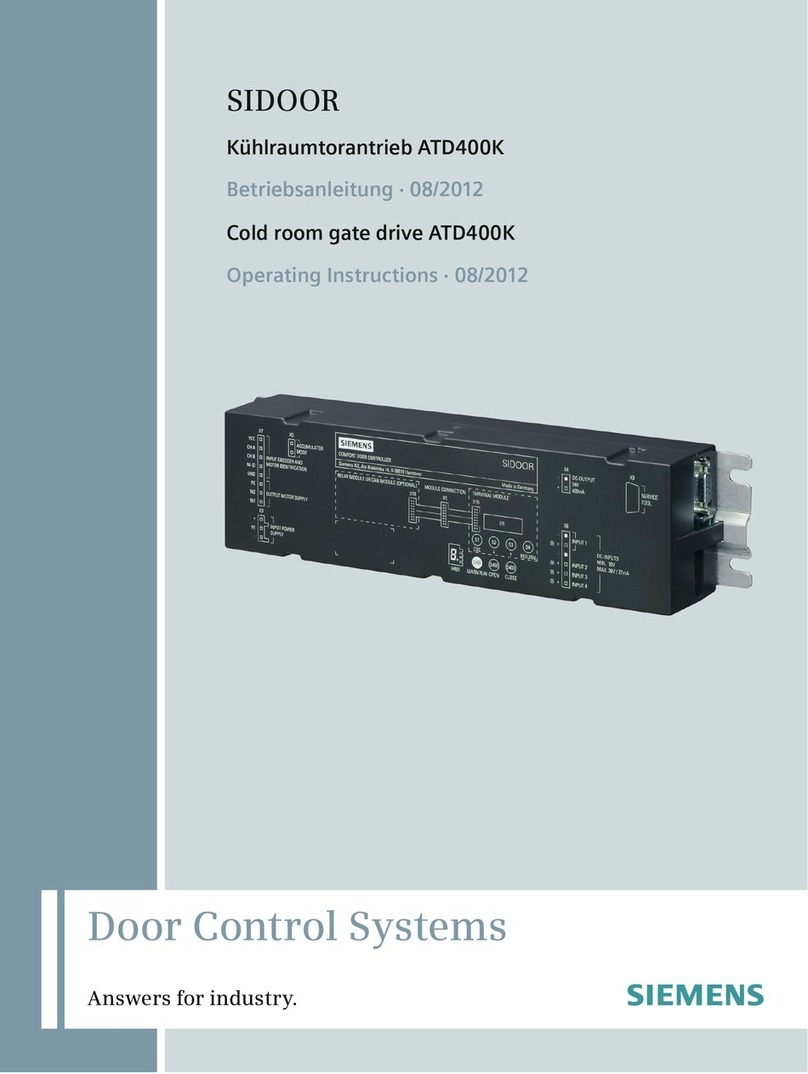
Siemens
Siemens SIDOOR ATD400K operating instructions
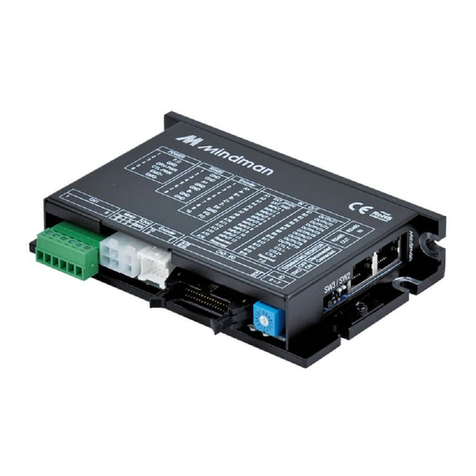
Mindman
Mindman CK10 Series user manual
